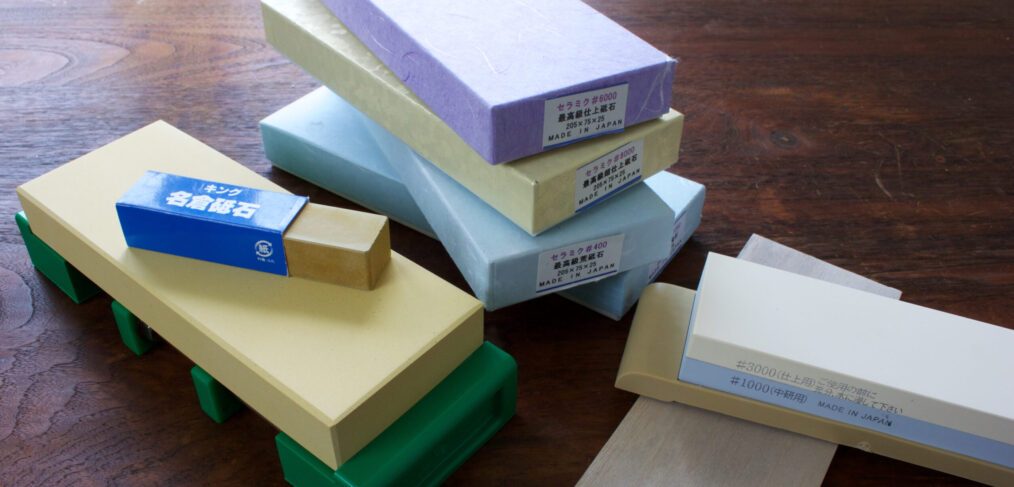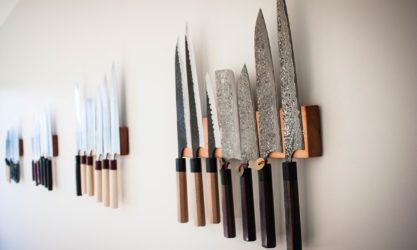
Japanese whetstones, everything you need to know.
I would like to talk about Japanese whetstones, in particular synthetic water stones because I get a lot of questions about this subject.
What is de difference between synthetic and natural stone?
Manmade sharpening stones have very consistent particle size and sharpen knives very well for a reasonable price. Besides manmade or synthetic stones there are also natural stones, which are most of the time expensive because of their scarcity. Natural stones have been used since the early days of tool making. When the synthetic sharpening stone where invented the use of natural stones declined.
A synthetic sharpening stone is made in a rectangular shape with an abrasive and a bonding product.
The amount of abrasive and bonding of the stone determines the cutting speed of the stone.
Sharpening stones have a grit size rating to refer how coarse or fine the stones are. The scale is similar to the scale used for sandpaper grits and that gives you and indication how fine or coarse stones can be.
Most synthetic sharpening stones range between 120 grit and 30 000 grit.
Sometimes the micron scale is used e.g. 1000 grit stone which is a very common grit size equals to 14.7 micron.
Artisan knives has sharpening stones from 400 to 8000 grit and this covers most applications.
As a cost effective alternative I offer pre loaded Balsa strops in 160000 and 32000 grit instead of expensive high grit stones.
Other products who are associated with sharping stones.
Nagura these are small stones to condition the abrasive surface and work up a slurry mix.
Slurry is a mix of water and stone particles.
A stone holder,which hold the stone in place and prevents it from moving around. I have spring loaded ones. Which makes it easy to switch stones and are a big improvement over the ones with a threaded rod and nut.
Ceramic honing rod this is the way to go for daily maintenance on your Japanese steel as a ceramic rod won’t micro chip the blade as a butchers steel does. Ceramic rods are made from the same abrasive and bond as the synthetic stones.
Flattening stone.
Sharpening stones tend to wear out in the spot where you sharpen the most. So using the whole surface of the stone when sharpening is the way to go.
With a flatting stone you grind the stone until flat again.
For Single bevel knife sharpening it is of the utmost importance to use flat sharpening stones.
Why is sharpening by hand on Japanese whetstones the best way to sharpen?
I have tried most ways of sharpening knives in the past.
And I’ve come to the conclusion that sharpening by hand on Japanese whetstones is the best way to sharpen.
Why Japanese synthetic whetstones?
With Japanese sharpening stones you get a high quality product with consistent grit size through the whole stone.
Why sharpening by hand?
No sharpening device can beat the human as we use our senses to feel, look and make sharpening decisions with our brain.
With our fine motoring skills we can lock in angles and hold them trough the stroke. We can make quick changes and hold them to allow for rounded portions on the blade near the tip. This is where sharpening machines with jigs and angle guides have their limitations.
Sharpening by hand is a slow and controlled process where you take the least amount of steel away to create a new edge.
By being slow and controlled it doesn’t heat up the blade like grinding sharpening equipment and leaves the blade temper intact.
By being slow and controlled it makes it easier to avoid making grinding mistakes. You sharpen and you check. Making sure you don’t grind to much steel away in certain area’s, and leave the profile intact.
Sharpening by hand on a stone give you feedback from that stone.
Using powered sharpening equipment takes the feel and feedback away.
Sharpening the edge isn’t the only thing you can do. By using a very shallow angle you can thin the portion closest to the edge of your blade, and raise the cutting performance of your knife. A thinner blade = less friction cutting trough a vegetable.
Most other sharpening devices can’t do this.
What are the advantages of learning to sharpening by hand?
It is a fun and relaxing activity.
The activity is a sort of meditation and the result gives you fulfillment.
It teaches you about control, observation and it is good to improve your fine motoring skills.
You never have to go with dull or not so sharp knives anymore.
You can maintain your knives to the highest level of sharpness.
Think about the cost of a basic sharpening set compared to the times you can have you knives sharpened for the same money.
What is a basic sharpening kit?
I would recommend 1000 – 4000 grit stones.
A 1000 grit stone to raise a new edge. 4000 grit stone to finish and refine that edge.
Here are some whetstone care tips.
Soak you whetstones 5 to 10 minutes in water prior to use.
Never leave you whetstones for extended periods in water.
After use leave the to air dry and out of direct sunlight.
The stones are water stones. Water is the only means of lubrication.
Do not use oil on these stones as lubrication.


Hi. I have a number of fish filleting knives which are always in need of sharpening. I have just bought a Victory knife which is sold (made?) in NZ.
I too have tried all sorts of machines, jigs, stones etc, but feel that the knives are never as good as they should (could) be.
Most seem to sharpen at about 22 to 29 deg, but notice that Japanese knives are 10 to15.
I would like to convert and keep my knives at that also. What are your thoughts on that and what stone kit might be best. I am an amateur fisherman so probably want something reasonably priced.
Hi Phil,
Thank you for your comment!
I believe the reason you are dissapointed with the edges is that an important step is overlooked and that is the removal of the wire edge.
(in my opion)
2 important “milestones” you need to get to in sharpenng a blade are; 1) creating a consistent burr along both sides of the blade and 2) removing that burr as a last step in the sharpening process.
When you remove that wire edge you get the true sharpness out. When you gently feel the edge with your fingers you get a feeling of bite.
You can do this by using gentle edge leading strokes on a whetstone, so you swoop the blade tip-heel or heel-tip with the edge leding on the sharpening stone.try to use the whole surface of the stone. Then feel for the bitey feeling.
I hope this answers you question.
The steel of Japanese Knives is generally harder and finer in grain structure. They can take that steeper angle better (10 -15 degrees). You will be able to do that with a sword knife but keep in mind you have to sharpen more often. Sharper V edge- less steel behind the edge more fragile (chipping)and chance of edge rolling over.
i would suggest to work on the better edges first before attempting steeper edges.
First of all i would recomend a japanese quality Sharpening stone. They come from coase to very fine and if it says 1000 grit you can be sure the whole stone is consistently 1000 grit.
If you want to keep the price resonable i would recomend the suehiro combination stone 1000/3000.
If you want to take it a bit further the sharpening i recomend full (200 mm x 70 mm size) 1000/4000-6000 grit stones for fish filleting.
1000 grit for removing the old tired steel and higher grits for honing – refining the edge.
Every so often flatten the sharpening stone because there is nothing worse than sharpening on a dished stone.
i hope this answers all you questions and best of luck sharpening.
Best regards
Tom